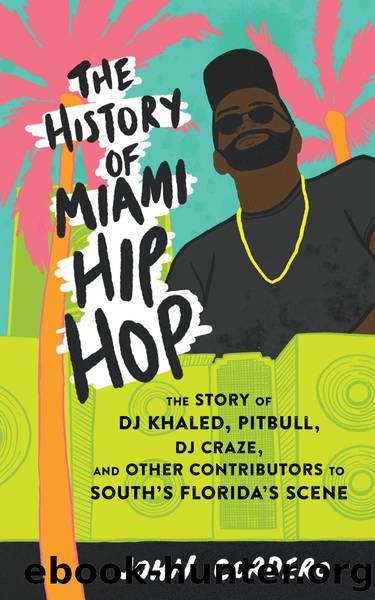The History of Miami Hip Hop by John Cordero

Author:John Cordero [Cordero, John]
Language: eng
Format: epub
Publisher: Microcosm Publishing LLC
Published: 2023-02-22T07:31:38+00:00
As Crook says âMiami is a tourist town. Millions and millions of dollars come from people who donât live here. They come here for a few daysâ¦they do not want graffiti all over the place. Shows that they donât have control. Iâll tell you one thing: Miami will never tolerate graffiti.â That is, unless itâs in the specially designated Wynwood Art District, where Art Basel pink pants wearing connoisseurs and hipsters on monthly art walks can patronize food trucks and Snapchat filter to death.
Now a free man, DJ Raw reflects on the turnaround of his old stomping grounds: âAfter the McDuffie riots and the Cano riots (in 1980 and 1990) most of that turf was burnt down and destroyed by us.â He laments. âThe mayor at that time came to see us and told us to stop burning down our own neighborhood, stop messing stuff up, and we did. But it was too late, we had ruined the neighborhood.â
Both of the civic disturbances were a result of police brutality against Miami inner city residents. A few days before Christmas 1979, Arthur McDuffie, a black resident of Liberty City, was beaten to death by four white Miami police officers after a high-speed chase. The ensuing manslaughter trial was moved to Tampa, and the four officers were acquitted in May 1980, leading to several days of rioting in Miamiâs inner city. After the flames were doused, the final toll was eighteen dead and over $100 million in damages.
Nearly a decade later, Miami police officers once again went over the line, with fatal results. In December 1990, six white and Hispanic officers were acquitted on charges stemming from the beating that led to the death of Leonardo âCanoâ Mercado, a street-level crack dealer in Wynwood. The ensuing rampage through Miamiâs historically Puerto Rican neighborhood resulted in three million in damages.
Wynwood may have remained just another inner city ghetto if not for Tony Goldman and other developers who took a risk at the start of the new millennium. They invested in a neglected area where the authorities and others only saw drugs and crime. DJ Raw gives his viewpoint on gentrification: âI think that itâs a plus, that they (the developers) came back and gave the opportunity for Hip Hop and for the graffiti artists to be able to embed themselves into the neighborhood and still give it that touch of class that it needs to sustain itself.â But before them, he contributed to the artistic renaissance that brought galleries and nightclubs to formerly dope boy infested streets: âI paid most of the graffiti artists back at that time (mid-90âs) to tag up, to bring that in. To see it evolve into where it is today? Thatâs pretty amazing.â
While Mayor Alex Penelas (of refusing to assist the federal government in the Elian Gonzalez case fame) and the Metro-Dade Police Department were putting the squeeze on the underground in the late 90âs, the South Beach ârap industryâ had mutated from its How Can I Be Down? experiment into a voracious monster swallowing everything in its path.
Download
This site does not store any files on its server. We only index and link to content provided by other sites. Please contact the content providers to delete copyright contents if any and email us, we'll remove relevant links or contents immediately.
The Goal (Off-Campus #4) by Elle Kennedy(13457)
Kathy Andrews Collection by Kathy Andrews(11705)
Diary of a Player by Brad Paisley(7458)
What Does This Button Do? by Bruce Dickinson(6121)
Assassin’s Fate by Robin Hobb(6101)
Big Little Lies by Liane Moriarty(5677)
Altered Sensations by David Pantalony(5027)
Pale Blue Dot by Carl Sagan(4883)
Sticky Fingers by Joe Hagan(4083)
The Death of the Heart by Elizabeth Bowen(3530)
The Heroin Diaries by Nikki Sixx(3478)
Beneath These Shadows by Meghan March(3248)
Confessions of a Video Vixen by Karrine Steffans(3229)
How Music Works by David Byrne(3154)
The Help by Kathryn Stockett(3066)
Jam by Jam (epub)(3003)
Harry Potter 4 - Harry Potter and The Goblet of Fire by J.K.Rowling(2971)
Strange Fascination: David Bowie: The Definitive Story by David Buckley(2780)
Petty: The Biography by Warren Zanes(2681)
